
On JANUARY 11, 2022
What is Customer Advocacy? Definition, Benefits, Strategy and Evaluation
Businesses depend on customers to succeed. There’s no arguing with that whatsoever. Unfortunately, not every business is customer-centric at its very core. This is a sorely missed opportunity. For one, businesses that lean into their customer advocacy as an extension of their marketing, sales, and customer service teams only stand to reap the benefits that come with transforming them from “purchasers” (of your products or services) to true brand ambassadors who are ready and willing to sing your praises at all times.
By making your customers your brand’s biggest fans, you’ll not only have a leg up on the competition—as loyal customers don’t often stray—but also will be able to funnel all of that love into creating a better overall customer experience that leads to happy customers over and over again. Here we'll explain what customer advocacy is and why it’s so important for your business.
In this article, we will be providing you with the most comprehensive guide to customer advocacy. Here are what you will achieve after delving deep into this blog post:
- Customer advocacy definition;
- What does a customer advocate do;
- How to increase customer advocacy?;
- How to implement a customer advocacy program?
- How to measure customer advocacy?;
- Substantial benefits of customer advocacy;
- Frequently asked questions about client advocacy
- Bottom line
If you're pumped and so do I, fasten your seatbelt and get the ball rolling!

What is Customer Advocacy?
Customer advocacy refers to the act of customers actively promoting and recommending a brand, product, or service to others. It goes beyond simple customer satisfaction and signifies a higher level of engagement and loyalty. Customer advocates are enthusiastic supporters of a company who willingly share their positive experiences with others, whether through word-of-mouth, social media, online reviews, or other channels.
Customer advocates are valuable assets for businesses because their recommendations and testimonials can significantly impact brand reputation, credibility, and customer acquisition. They are willing to go above and beyond to promote a brand, acting as voluntary brand ambassadors.
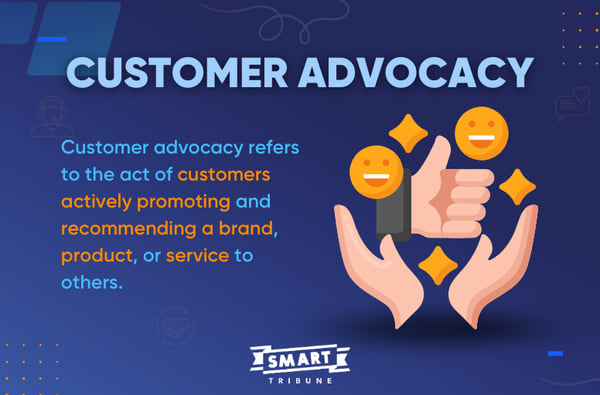
Customer advocacy is often a result of exceptional customer experiences, personalized interactions, and a strong emotional connection between the customer and the brand.
What Makes A Customer An Advocate?
As a matter of fact, customer loyalty doesn’t just happen overnight. It’s actually a rather drawn-out process that begins with the very first interaction a customer has with your brand.
If that initial customer experience is a good one, then it likely ends with a customer making a purchase, signing up for the newsletter, following your brand on social media, and so on.
The key here is to get a customer to make a transaction of some sort, as that is absolutely essential in getting them one step closer to building a relationship with a brand.
Obviously, if that first interaction wasn’t a positive one, then you probably lost a customer right off the bat—which is an entirely separate beast that we won’t tackle in this article. Our focus here is on happy customers and how they can be a lever for your business’s long-term success.
Learn more about How to Deal with Angry Customers? - Causes, Signs, and Guide.
Now, back to our happy customers. Once they’ve made a transaction, it’s now up to you—the brand—to surprise and delight them at every turn. A big part of this involves ensuring that your product or service, in other words, whatever they’ve purchased from you, meets (and hopefully) exceeds their expectations. Ideally, if you’ve satisfied them enough to get them to make a repeat purchase, you’re well on your way to earning a loyal customer for life.
Just keep in mind that a positive experience with a product or service is merely one part of the path-to-customer advocacy equation. Every aspect of the customer experience, from your brand’s website to social media to email communications—and pretty much anything else you do to engage with customers in a one-to-one or one-to-many way—will shape their perceptions of your brand. The more you can do to make that total experience feel personally relevant to your customer, the more likely your brand will rank high in their favorites.
What Does A Customer Advocate Do?
It's not rocket science to immediately recognize your customer advocate. They stand out by engaging in various typical activities. If you haven't encountered one, here come customer advocacy examples:
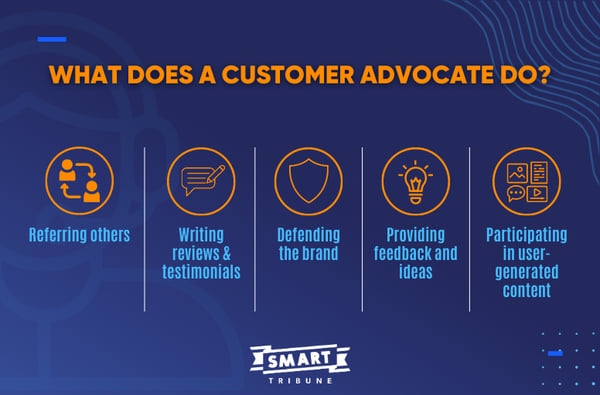
- Referring others: Advocates actively refer their friends, family, colleagues, or social media followers to the brand. They share positive experiences and recommend products or services to others who might benefit from them.
- Writing reviews and testimonials: Customer advocates voluntarily write positive reviews, testimonials, or case studies about their experiences with a brand. These reviews can be shared on review platforms, social media, or the company's website, helping to build trust and credibility.
- Defending the brand: When a brand faces criticism or negative feedback, customer advocates often step in to defend the brand, sharing their own positive experiences and countering negative comments. They may engage in conversations or debates online to protect the brand's reputation.
- Providing feedback and ideas: Advocates actively contribute their ideas, suggestions, and feedback to help the brand improve its products, services, or overall customer experience. They provide valuable insights based on their own experiences and can be seen as a trusted source of feedback.
- Participating in user-generated content: Customer advocates may voluntarily create content related to the brand, such as blog posts, videos, or social media posts. They share their experiences, tips, or creative uses of the brand's products or services, contributing to the overall brand narrative.
By prioritizing customer satisfaction and engagement, businesses can cultivate a base of loyal customers who willingly advocate for the brand, leading to increased brand awareness, customer acquisition, and business growth.
Discover Why – and How – Should Customer Satisfaction Be Measured?
How to Increase Customer Advocacy?
Increasing customer advocacy is crucial for the success and growth of any business. When customers become advocates, they not only continue to do business with you but also actively promote your brand to others. Here are some strategies to increase customer advocacy:
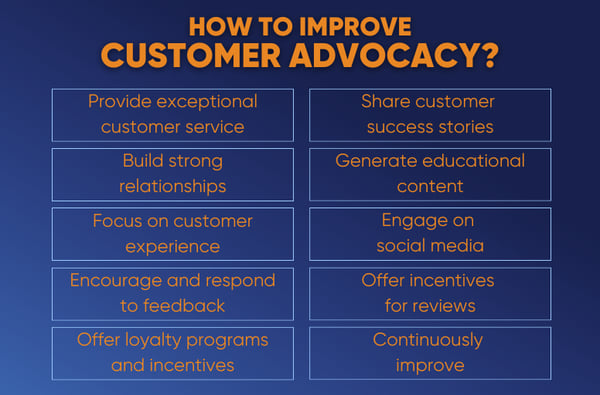
1. Provide exceptional customer service: Delivering outstanding customer service is the foundation of customer advocacy. Train your staff to be attentive, responsive, and empathetic. Resolve customer issues promptly and go the extra mile to exceed their expectations.
2. Build strong relationships: Develop meaningful relationships with your customers by engaging with them on a personal level. Brands can show genuine interest in their needs, preferences, and feedback by regularly communicating with customers through multiple channels, such as email, social media, and personalized offers.
3. Focus on customer experience: Create a seamless and delightful customer experience across all touchpoints. From the first interaction to post-purchase support, ensure consistency and quality. Make it easy for customers to interact with your brand, navigate your website, and access your products or services.
4. Encourage and respond to feedback: Actively seek feedback from your customers on multiple channels, such as surveys, reviews, and social media, to understand their experiences and expectations. Acknowledging and responding to feedback promptly, and addressing both positive and negative comments will make your brand stand out from the crowd.
5. Offer loyalty programs and incentives: Implement a loyalty program that offers incentives, discounts, exclusive offers, or special perks. Brands can also encourage customers to refer others by providing referral bonuses or discounts for successful referrals.
6. Share customer success stories: Highlight customer success stories and testimonials to showcase the value your products or services provide on your website, social media channels, and marketing materials. Authentic and relatable stories can inspire other customers to become advocates.
7. Generate educational content: Share valuable content, including blog articles, tutorials, videos, or webinars, that educates and helps customers achieve their goals. Position your brand as an expert and trusted resource in your industry, and customers will appreciate and share your content.
8. Engage on social media: Businesses should put in time and effort to respond to customer comments, questions, and concerns wherever they are on their buyer journey. Use social listening tools to monitor brand mentions and engage with users who are discussing your products or services.
9. Offer incentives for reviews: Encourage customers to leave reviews on platforms like Google, or industry-specific review websites by offering incentives, such as discounts or entry into a contest. Positive reviews from satisfied customers can significantly boost your credibility and attract new customers.
10. Continuously improve: Actively listen to your customers and use their feedback to elevate your products, services, and overall customer experience. Show that you value their input by implementing changes based on their suggestions. This demonstrates that you are committed to meeting their needs and fosters advocacy.
Keep in mind that building customer advocacy takes time and effort. Consistently prioritize the needs of your customers, deliver phenomenal experiences, and foster genuine relationships, and you'll be on your way to creating a strong base of customer advocates.
How to Implement A Customer Advocacy Program?
Many companies don’t leave customer advocacy to chance. Nor should they because building customer advocates is something that requires a bit of nurturing. This has given rise to customer advocacy strategies, like customer loyalty programs, that seek to formalise the relationship between brands and their customers.
In a nutshell, a successful customer advocacy program is built on the following components:
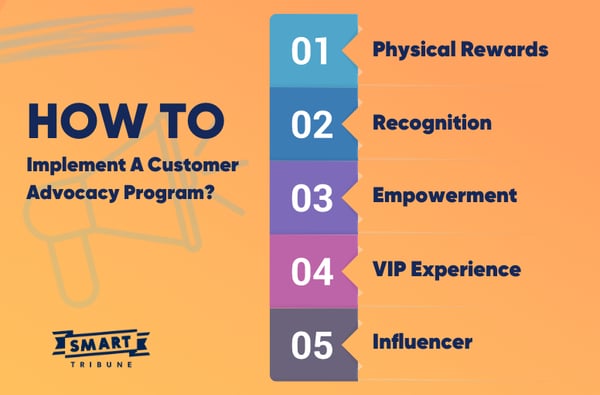
- Physical Rewards: Whether you offer points for every purchase made or amount spent—which can later be used to unlock perks or freebies—the goal here is to gamify the customer loyalty so that customers are incentivised to be repeat purchasers.
- Recognition: Aside from earning points and other rewards, customers love to be shown a little bit of gratitude or recognized for their ongoing support and patronage. Even the smallest gestures of appreciation, like sending an email along with a discount code to celebrate a customer’s birthday, for example, can go a long way towards making customers feel as though your brand truly cares about them as people.
- Empowerment: The more loyal your customers become, the more likely they’ll want to play their own unique part in helping to make your brand—including the products and services you offer—even better. Inviting them to participate in surveys and focus groups where they can provide candid feedback is a great tactic for deepening customer engagement. Now, here’s the hitch: As we’ve said many times before, if you choose to ask customers for feedback, you must take action on it and show that it wasn’t done simply for the purposes of data collection. Today’s customers are really savvy and can see right through inauthenticity. So if you open these flood gates, be ready to act.
- VIP Experience: Many brands have built their rewards program around tiers. In other words, as a customer earns more loyalty points, they can reach new levels of loyalty that unlock new and exclusive rewards designed for the most dedicated brand advocates. This may include invites to events, increased discounts, birthday gifts, and so on. A great example of this is Starbucks’ loyalty program (should you need some inspiration).
- Influencer: Once certain customers have proven their unwavering loyalty to a brand, they can reach influencer status and serve as bonafide brand ambassadors by creating (social media) content on behalf of the brand, participating in speaking opportunities at sponsored events, getting invited to meet with a company’s senior leaders, and more. The ultimate goal for any customer advocacy program is for a brand to turn its most loyal customers into “promotional megaphones” that can create a ripple (or network) effect of loyalty with their own followers.
How to Measure Customer Advocacy?
Measuring customer advocacy is of paramount importance to understand the influence of your efforts and track the level of customer advocacy over time. While customer advocacy is not always straightforward to quantify, there exist several key metrics and methods you can use to measure it. Here are some approaches to measuring customer advocacy:
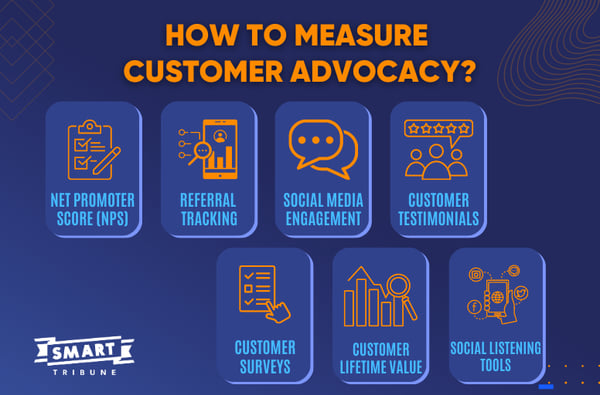
1. Net Promoter Score (NPS): NPS is a widely used metric that measures the likelihood of customers recommending your brand to others. It involves asking customers a simple question: "On a scale of 0-10, how likely are you to recommend our company/product/service to a friend or colleague?". Based on their responses, customers are categorized into:
- Promoters (score 9-10),
- Passives (score 7-8),
- Detractors (score 0-6).
Subtracting the percentage of Detractors from the percentage of Promoters gives you the NPS.
2. Referral tracking: Monitor the number of referrals you receive from existing customers by asking new customers how they heard about your business and tracking referrals back to the advocating customers. You can also use referral tracking software or unique referral codes to determine the exact number of referrals.
3. Social media engagement: Track the level of engagement and interactions on your social media channels by looking for comments, likes, shares, and mentions related to positive advocacy and recommendations from customers. Monitoring social media conversations can also provide insights into the level of customer advocacy and brand awareness.
4. Customer testimonials and reviews: Business owners can monitor platforms like Google, Yelp, industry-specific review sites, and their own websites for customer feedback. As they keep track of the number and quality of customer testimonials and reviews they receive, business owners can analyze the sentiment of reviews and track any trends or changes over time.
5. Customer surveys: It is highly recommended that organization should conduct surveys on a regular basis to gather feedback from customers. Include questions that assess their willingness to recommend your brand and their overall satisfaction level. You can also include open-ended questions to capture qualitative insights about advocacy behaviors and the reasons behind their recommendations.
6. Customer lifetime value (CLV): Advocates tend to have higher CLV as they are more likely to make repeat purchases, refer others, and have a longer-term relationship with your brand. Tracking changes in CLV can give you an indication of the impact of customer advocacy on your business.
7. Social listening tools: Utilize social listening tools to monitor online conversations about your brand. Look for mentions, sentiment analysis, and trending topics related to customer advocacy. This can help you identify brand advocates, track their activities, and measure the reach and impact of their advocacy efforts.
It's integral to combine quantitative and qualitative data to gain a holistic understanding of customer advocacy. Additionally, consider benchmarking your results against industry standards or competitors to gain further insights. Regularly analyzing and tracking these metrics will enable you to measure the effectiveness of your customer advocacy initiatives and make informed decisions to improve customer advocacy over time.
Why is Customer Advocacy Important?
Now that we’ve provided a high-level overview of what customer advocacy is, why it’s important, and how to build an effective customer loyalty program, let’s take a closer look at why mounting an army of brand advocates not only makes good business sense but also is the key to creating a better overall customer experience—for all of your customers.

Customer advocacy builds long-term brand loyalty
Let’s start by stating the obvious. Customer advocacy is basically the logical extension of customer loyalty. You can’t really have one without the other. What a customer advocacy program does, however, is amplify existing brand loyalty by giving customers even more reasons to not want to potentially flirt with the nearest competitor. Building a more formal, mutually beneficial relationship with customers is the key to making brand loyalty feel like an authentic part of your brand’s end-to-end customer experience. This helps explain why Forrester found that, on average, customer advocates are far more loyal than non-advocates.
Customer advocacy reinforces customer retention
This goes hand-in-hand with the point above. After all, loyal customers are bound to stick around for the long haul and not deflect over to the competition. Because customer advocacy is all about giving customers more reasons to be loyal to brands, it only makes sense that it also doubles as a tried-and-true customer retention tactic. And although customer retention is, more or less, a synonym for customer loyalty, the truth is, it plays more into the “bottom line” economics of customer loyalty. In other words, the biggest business benefit here is that the longer customers remain loyal, the greater their lifetime value to your brand will be.
Customer advocacy gives sales a boost
You might start noticing a trend here. When customers are loyal, they tend to come back and make ongoing or, in this subscription-focused era, recurring purchases. But it has also been found that customer advocates often spend twice as much as non-advocates—and also tend to purchase more often, making them up to five times more valuable than the average customer. Additionally, simply increasing your customer advocacy efforts by 12% can double your brand’s revenue growth. Why? Because brand loyalists have the power and influence to create a network effect that brings in new customers organically who are ready to spend on your brand.
Customer advocacy improves overall customer satisfaction
Customer loyalty and customer satisfaction are essentially two sides of the customer advocacy sword. Brand advocates are loyal because you, as a brand, have done something to make them happy. Whether they love your products and services or had a stellar customer service interaction—and pretty much anything in between—you’ve been able to satisfy their wants, needs, and expectations in some way. Now, here’s the icing on the cake: Customer advocacy creates a space for driving even greater levels of customer satisfaction simply by giving your customers more ways to positively promote and engage with your brand. And this quickly becomes a virtuous circle because the more satisfied they are—or rather, the more you’re able to continue surprising and delighting them—the more of an advocate they’ll be down the road.
Customer advocacy can help minimise customer acquisition costs
As you’ve heard many times before, retaining a loyal customer is a lot more cost-effective than acquiring a new customer—much less during times like these when CPCs and CPAs are higher than ever because it’s harder to break through the noise and capture the attention of your target customers. Therefore, by making customer advocacy a cornerstone of your customer nurture strategy, you essentially transform these brand advocates into an extension of your sales team and, as a result, create an organic new customer acquisition pipeline.
Knowing that customer advocates are often two to three times more effective at persuading others to make a purchase (versus their non-advocate counterparts) through word-of-mouth promotions, you’d be silly not to lean on them to bring new customers into the fold. Plus, if you needed more convincing, it’s also been found that 76% of people say they are more likely to trust content shared by “normal people” than what’s shared directly by brands themselves. So if you’re reading between the lines, this is basically free customer acquisition.
Customer advocacy increases brand awareness
Speaking of new customer acquisition channels, such as Facebook ad campaigns, one of the biggest barriers of entry for any customer when it comes to trying out a new brand is simply knowing that the brand exists in the first place. This is where customer advocates can really come in handy. Not only do they spread the word more often about the brands they love, but Nielsen has also found that the people who trust and respect their recommendations are four times more likely to buy based on a referral. So while customer advocates are great influencers who have the ability to drive brand awareness, as noted above, they are equally strong at closing sales, albeit indirectly.
Customer advocacy makes it easier to identify customer needs proactively
As mentioned earlier, a well-thought customer advocacy program opens up the door to gleaning useful insights from customers that can help you shape, evolve, and improve both your products and services as well as the overall customer experience. Because customer advocacy is all about creating a more open and ongoing dialogue with customers—in other words, building strong customer relationships—it’s an opportunity for brands to get a pulse on customer needs well before issues boil over. But we can’t stress it enough that should you decide to embrace customer input and feedback with open arms, you need to have a plan in place to take action on it—and communicate your action plan out to customers accordingly.
Customer advocacy creates a support system for other customers
If you operate an on-domain customer community or have a vibrant social media presence—especially on channels like Facebook Groups—you can empower your customer advocates to help and support other customers who aren’t as “in the know” as they are. Doing so can, in many ways, make them an extension of your customer service team by giving them the authority to respond to other customer questions or issues via community forums. As an added plus, this has the potential to create a “domino effect” of customer advocacy because the more other rank-and-file customers see “super users,” for lack of a better word, support the broader customer community, the more they will aspire to reach that same level of customer advocacy. In other words, customer advocates model the behaviours that they’d like to see in other customers and, as a result, become catalysts for a new wave of customer advocates.
FAQs about Customer Advocacy
What is client advocacy or What does customer advocacy mean?
Client advocacy or customer advocacy refers to the act of product shoppers or service users recommending, referring, leaving reviews, giving feedback, etc. to their favourite brands to disseminate the brand's popularity.
How can social media listening increase customer advocacy?
Social media platforms enable customer advocacy improvement by allowing to identify brand advocates, respond to customer feedback, engage in conversations, identify customer pain points, leverage user-generated content, and identify influencers and partnerships, etc. This knowledge empowers you to respond effectively, engage with customers, and address their concerns, ultimately fostering stronger relationships and increasing customer advocacy for your brand.
Customer Advocacy is A Byproduct of Great Customer Experiences
Creating amazing customer experiences across the entire customer journey should be the number one priority for all brands today. This is the key to long-term customer advocacy.
And while there are a lot of different ways to create a better, more engaging end-to-end customer experience, one winning approach is to deploy customer self-service solutions on your site. Whether you decide to exploit a comprehensive knowledge base, dynamic FAQ, intelligent chatbot, or in-context help widget—or all of the above—putting more and better information in your customers’ hands whenever and wherever they need it will make them resilient.
It is well proven that the happier your customers are, the more likely they’ll remain loyal to your brand. If you’ve put a solid customer advocacy program in place, they’ll likely become brand advocates, too.
To learn more about how you can make customer self-service the go-to customer service channel for your online customers, check out our insightful on-demand webinar today.

.png)



